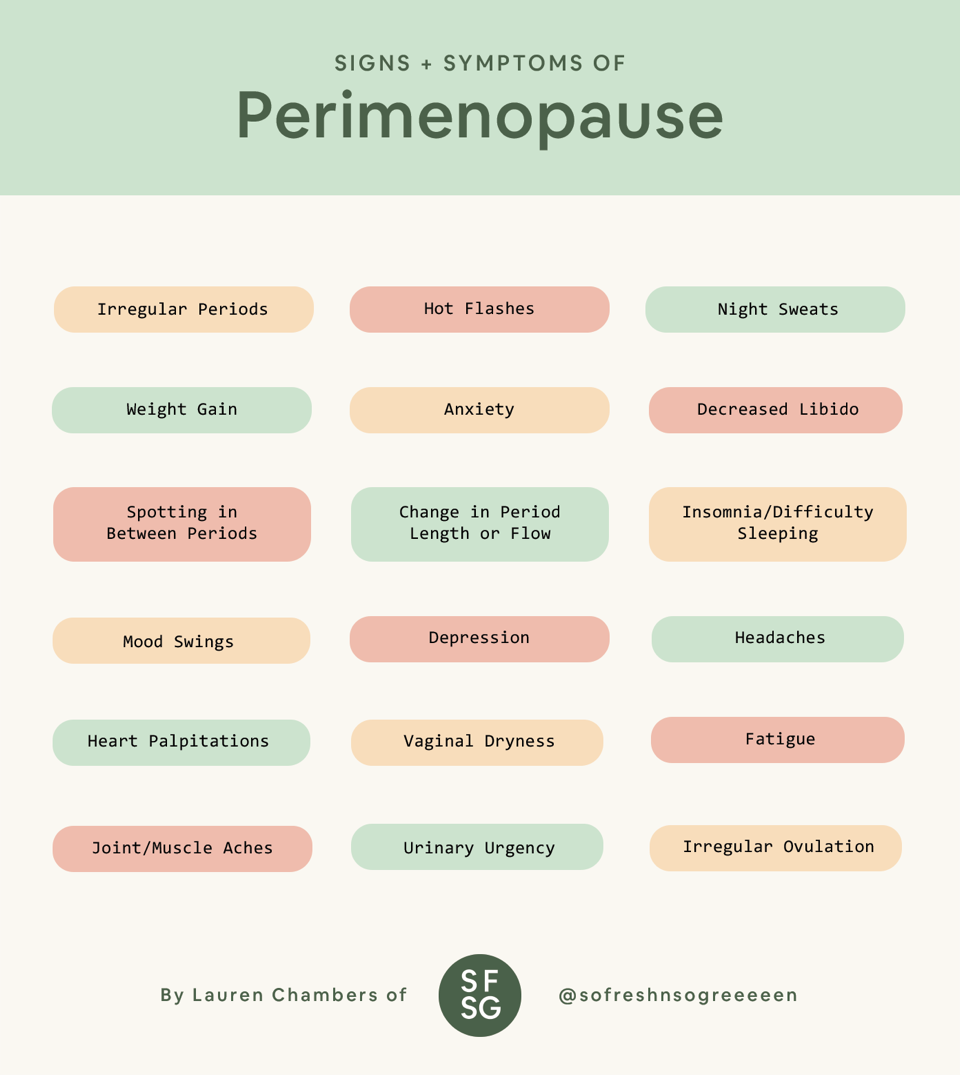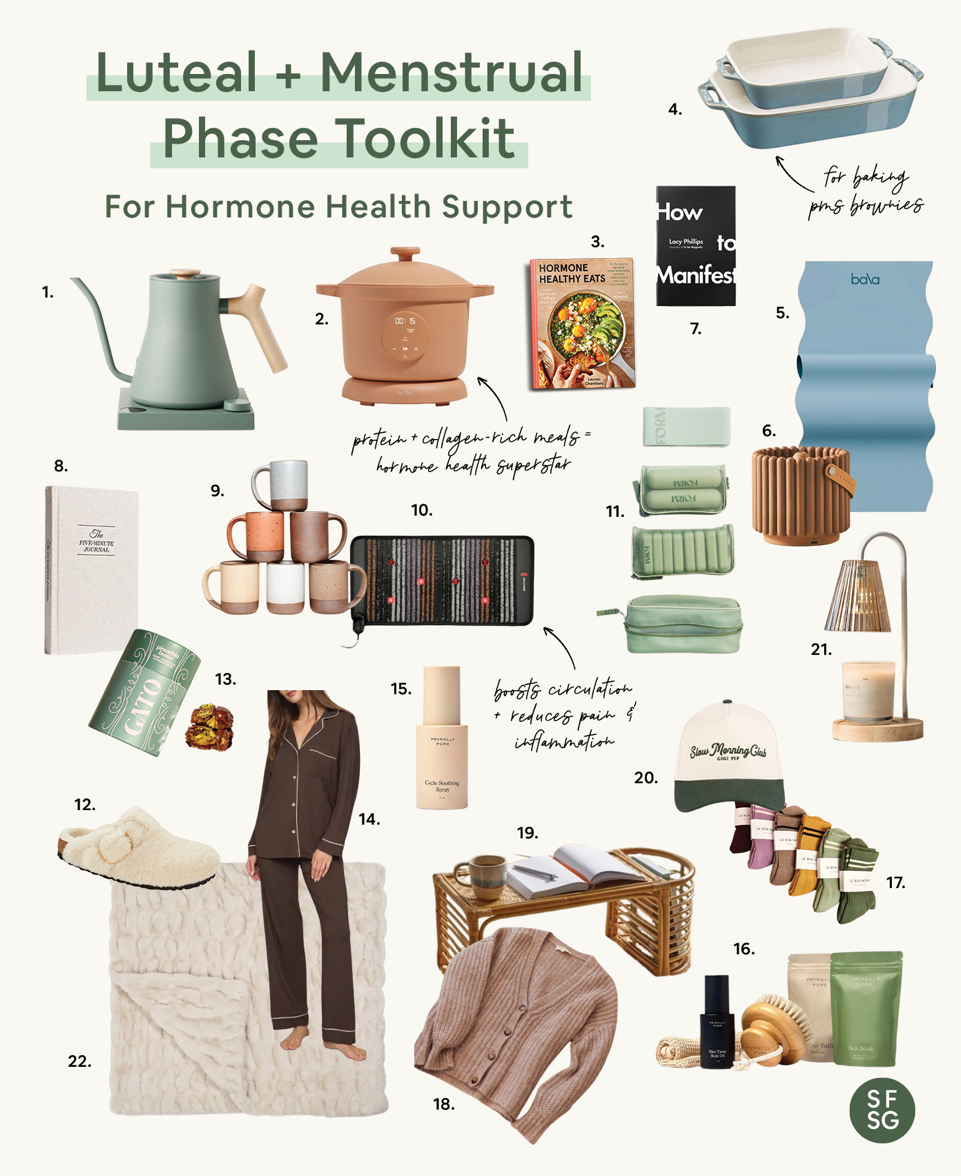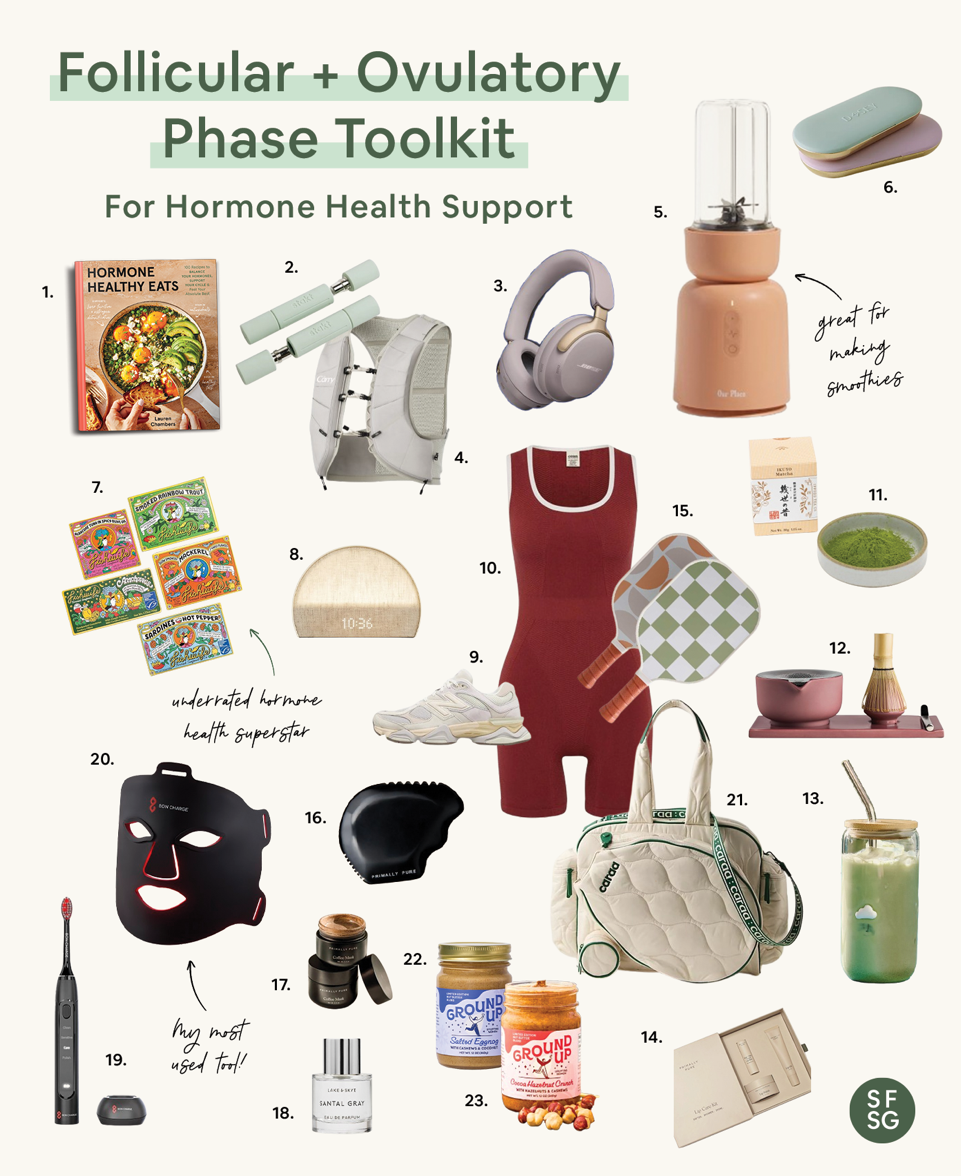recipes
lifestyle
wellness
motherhood
mindset
About
E-Books
Blog
Freebies
partnerships
hi, i'm lauren!
hey there!
I’m on a hot mission to help you balance your hormones & live your best life.
categories
Home
Quiz
Get In Touch
The Course
search:
Cookbook
Recipe key
GF
VG
P
Vegan
Gluten Free
Paleo
DF
Dairy-Free
download now
Join Hormone Healthy Eats!
Become a SFNSG insider to get my monthly Substack, Hormone Healthy Eats! Packed with the latest hormone-healthy recipes
+ tips.
jump to recipe >
Depending on your age and where you’re at on your hormone health journey, perimenopause may or may not be on your radar.
TBH for many years it was something I didn’t think I had to think about….but now, knowing everything I know as a nutrition and hormone health coach, I feel very passionate about educating women on the subject of perimenopause, and the earlier the better!
Because here’s the thing: how we care for ourselves and our hormones in our twenties and thirties has a HUGE impact on how we feel as we transition into perimenopause and eventually menopause.
And I don’t know about you, but I don’t want to dread this next chapter of my life. I want to continue to age gracefully and enjoy everything life has to offer, instead of dealing with uncomfortable or even debilitating symptoms.
That being said, if you are already struggling with perimenopause I want you to know it’s not too late! You still have so much power to reduce your symptoms and feel better almost immediately.
This post will help you determine if you are, in fact, entering into or currently in perimenopause. If so, I’ve got another post to help you support your hormones during this transition and feel as good as you possibly can.
With that being said let’s jump into it!
Need help balancing your hormones + reducing symptoms? Get on the waitlist for my online course, opening for enrollment soon!
WHAT IS PERIMENOPAUSE?
Perimenopause refers to the period of time when your body starts making the natural transition to menopause, and the ovaries gradually produce less reproductive hormones such as estrogen and testosterone, ultimately marking the end of your menstrual cycle and reproductive years.
Perimenopause can occur anytime in your 30’s to 50’s, and typically lasts anywhere from 4-8 years. When your hormones are supported and healthy, this transition should be smooth, unfortunately most women experience a variety of uncomfortable symptoms that are heightened due to pre-existing hormonal imbalances and conditions.
PERIMENOPAUSE SYMPTOMS QUIZ
For those wanting to dive right into the free perimenopause symptoms quiz, you can begin by clicking on the button below. This quiz is not an official diagnosis but it will help you determine whether or not you may be experiencing symptoms of perimenopause, and if so what to do about it!
SIGNS + SYMPTOMS OF PERIMENOPAUSE
Some of the most common signs and symptoms of perimenopause include:
-
+ Irregular Periods
-
+ Irregular Ovulation/Decreased Fertility
-
+ Spotting In Between Periods
-
+ Change in period length or flow
-
+ Hot Flashes
-
+ Night Sweats
-
+ Sleep Disturbances
-
+ Anxiety
-
+ Weight Gain
-
+ Decreased Libido
-
+ Mood Swings
-
+ Depression
-
+ Headaches/Migraines
-
+ Heart Palpitations
-
+ Vaginal Dryness
-
+ Fatigue
-
+ Urinary Urgency
-
+ Muscle/Joint Aches and Pains
-
+ Tender/Swollen Breasts
-
+ Fluid Retention
-
+ PMS-Like Symptoms
WHAT’S HAPPENING TO HORMONES DURING PERIMENOPAUSE
If you’re experiencing any of the above symptoms, you might be wondering…why? In order to answer that, it’s important to understand the transitions that are taking place within your body and your reproductive hormones and this time:
+ Irregular Ovulation = Less Progesterone
As we get older, our follicles aren’t as active and ovulation starts to become irregular (leading to anovulatory cycles or cycles where we do not ovulate). Ovulation is a vital part of progesterone production, so therefore we begin to make less progesterone. Because progesterone is our cool, calm and relaxing hormone that helps us foster a healthy endometrium lining to potentially house a baby, is necessary for both a healthy pregnancy and menstrual cycle, and needed to keep estrogen in check as well as PMS at bay, you can see why symptoms start to crop up!
+ Less Progesterone = Disproportionate Estrogen to Progesterone Ratio
Because we are naturally making less progesterone, this often leads to a disproportionate balance in estrogen to progesterone ratio, also known as relative estrogen dominance. While you can also experience a decline in estrogen during perimenopause (with a significant drop during menopause) it’s much more likely to experience high estrogen first, or estrogen spikes, which can lead to many of the symptoms mentioned above (which also are often associated with PMS).
PERIMENOPAUSAL SYMPTOM ROOT CAUSES
Because these shifts in hormone production and balance are an inherent part of perimenopause, you might be thinking it’s impossible to avoid the symptoms associated with it.
Luckily, that is not the case, and while symptoms are very common, they are often heightened or more noticeable due to the following:
+ Pre-Existing Hormonal Imbalances or Conditions
If you already are dealing with a hormonal imbalance (such as estrogen dominance, low progesterone, high cortisol, low thyroid, etc.) condition (such as PCOS) or other health issues, you are most likely already experiencing symptoms, which are then often amplified during perimenopause. These imbalances often are a result of, or go hand in hand with the following:
+ Nutrient Deficiencies
Depletion is a key culprit of hormonal imbalances, as nutrients derived from the foods we eat provide the raw materials for hormone production and synthesizing. Not only that, but orchestrating a healthy menstrual cycle, primarily through ovulation, requires A LOT of energy, which is obtained via nutrients from food. If we want to have a seamless transition into perimenopause, we must ensure we are having as many healthy ovulatory menstrual cycles as possible, which requires nutrients, nutrients and more nutrients.
+ Chronic Stress Exposure
Ahh, stress…always on the list isn’t it? Unfortunately our exposure to chronic stressors impacts our hormones negatively in a myriad of ways, and it’s no different with perimenopause! This is in large part due to the fact that progesterone shares the same precursor hormone as cortisol (our primary stress hormone) called pregnenolone.
If our adrenal glands are constantly pumping out cortisol due to stressful encounters all day long, they eventually run out of the precursor hormone, and so they borrow it from progesterone in a process known as the “pregnenolone steal.” Because of this, our body has less to work with to produce progesterone, often leading to low progesterone levels and the symptoms that accompany it, which then become magnified during perimenopause.
+ High Histamine Levels
High histamine is linked to perimenopausal symptoms, mainly because histamine increases with estrogen, and estrogen is higher during perimenopause (it often spikes before it plummets). Histamine is an immune and inflammatory mediator as well as a stimulating neurotransmitter, which when high or not properly cleared from the body can lead to symptoms ranging from skin conditions, insomnia, anxiety, headaches, brain fog or fluid retention. If you have high histamine levels, you may notice these symptoms right around ovulation, when estrogen is typically at it’s highest.
+ Gut Health or Liver Issues
Because both the gut and liver are intricately involved in safely removing excess estrogen from the body, if these systems are burdened or not functioning optimally (due to stress, toxin exposure, antibiotics or OTC’s, too much caffeine, alcohol or processed foods, etc.), it can often lead to excess estrogen. If estrogen is already dominant as you enter into perimenopause, it can dramatically heighten already uncomfortable symptoms.
HOW TO REDUCE SYMPTOMS + SUPPORT HORMONES DURING PERIMENOPAUSE
As Lara Briden, well-known Naturopathic Doctor, research biologist and author of The Period Manual and The Hormone Repair Manual states “Perimenopause as a barometer of health means that the best treatment for perimenopausal symptoms is often the treatment you needed anyway.”
AKA, the tools and lifestyle practices that help to reduce symptoms and help you feel better are simple ones that most women could benefit from doing at any point in our lives. Below are a few of my top tips specific to perimenopause, and you can read more detailed action steps and tips in this post.
-
+ Prioritize Protein
-
+ Strength Train
-
+ Reduce Stressors
-
+ Support Adrenal Glands
-
+ Boost Detox Pathways
-
+ Practice Good Sleep Hygiene
-
+ Regulate Circadian Rhythm
-
+ Consume Progesterone-Boosting Foods
-
+ Align With Your Menstrual Cycle
-
+ Reduce Caffeine/Alcohol Intake
-
+ Incorporate Digestive Bitters + Herbs
WHY IT’S IMPORTANT TO PREPARE FOR PERIMENOPAUSE
If you’ve made it this far and you’ve determined from the perimenopause symptoms quiz you’re most likely not yet in perimenopause, that’s great! It is never to early to prepare, and how you care for yourself and your hormones now will set the tone for your hormone health now, as well as perimenopause, menopause and beyond.
Remember, if you enter into this stage already dealing with hormonal imbalances and the symptoms associated with them, these will only become magnified during perimenopause. While this transition does come with hormonal shifts, you are not meant to feel pain, discomfort or suffer. Supporting yourself now paves the way for a smooth transition into the next chapter and empowers you to live a life free of symptoms.
EXPERIENCING SYMPTOMS BUT NOT IN PERIMENOPAUSE?
If you experience symptoms commonly associated with perimenopause but are not, in fact, in perimenopause yet, I’d encourage you to investigate further. Many of the symptoms associated with perimenopause are also common symptoms of excess estrogen or low-progesterone, and are often similar to PMS. Again, I feel as though I can’t emphasize enough that while these symptoms are common, they are not normal, and you should not have to suffer through them. Period.
MORE PERIMENOPAUSE RESOURCES
+ How to Balance Hormones Naturally During Perimenopause
+ Tips To Lower Cortisol Naturally
+ 9 Tips To Support Estrogen Detox Naturally
This post contains affiliate links. We may receive a small commission for purchases made through these links. Thank you for your support!

If you loved that...

01.

02.

03.

04.

05.
hey!
Keep Browsing
Site
Keep Browsing
Site
the
about
e-books
blog
downloads
quiz
Welcome friend, I'm lauren.
I’m honored to support you on your journey to optimal hormone health + happiness. Thanks for being here babe.


